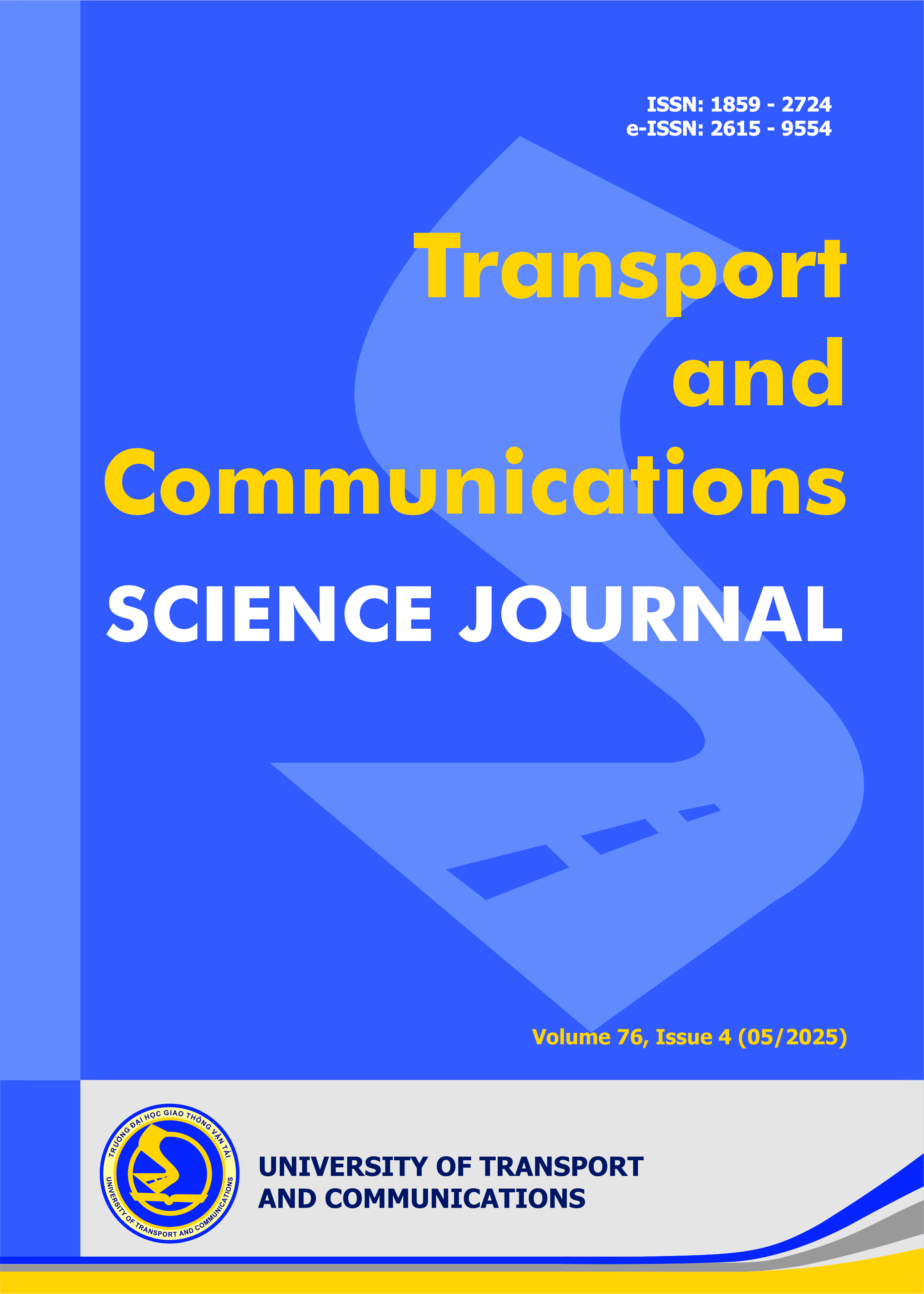An optimal solution for integrating PV energy sources into the distribution network
Email:
tvkhoi.ktd @utc.edu.vn
Từ khóa:
Năng lượng tái tạo, Nguồn phân tán, Quản lý năng lượng, Thuật toán tối ưu, Tối thiểu hóa tổn hao điện năng, Dao động điện áp
Tóm tắt
Vietnam, situated near the equator, receives high solar radiation, making it a crucial factor in addressing the urgent global shift to renewable energy sources. This transition aims to reduce CO2 emissions and achieve carbon neutrality by 2050. In the context of effectively harnessing solar energy, this paper presents a solution for identifying the location and power of renewable energy systems integrated into the distribution network. The objective is to minimize transmission power loss and voltage fluctuations while maximizing profits. The proposed solution involves using the Newton-Raphson algorithm to determine energy distribution on the power network in specific scenarios. Subsequently, the Hill Climbing algorithm is applied to identify the optimal location for deploying the renewable energy system on the power network. Moreover, a method for determining the power of renewable energy systems is implemented to minimize the objective function utilizing the Newton method. Experimental validation on the IEEE 33 bus and 69 bus test systems demonstrates that the proposed methodology consistently achieves optimal results expediently, underscoring its efficacyTài liệu tham khảo
[1]. Dongyang Zhang, Yumei Guo, Farhad Taghizadeh-Hesary, Green finance and energy transition to achieve net-zero emission target, Energy Economics, 126 (2023) 106936. https://doi.org/10.1016/j.eneco.2023.106936
[2]. Zeineb Abdmouleh, Adel Gastli, Lazhar Ben-Brahim, Mohamed Haouari, Nasser Ahmed Al-Emadi, Review of optimization techniques applied for the integration of distributed generation from renewable energy sources, Renewable Energy, 113 (2017) 266-280. https://doi.org/10.1016/j.renene.2017.05.087
[3]. Karim L. Anaya, Michael G. Pollitt, Integrating distributed generation: Regulation and trends in three leading countries, Energy Policy, 85 (2015) 475-486. https://doi.org/10.1016/j.enpol.2015.04.017
[4]. U. Sultana, Azhar B. Khairuddin, M.M. Aman, A.S. Mokhtar, N. Zareen, A review of optimum DG placement based on minimization of power losses and voltage stability enhancement of distribution system, Renewable and Sustainable Energy Reviews, 63 (2016) 363-378. https://doi.org/10.1016/j.renene.2019.09.117
[5]. Hamidreza Sadeghian, Zhifang Wang, A novel impact-assessment framework for distributed PV installations in low-voltage secondary networks, Renewable Energy, 147 (2020) 2179-2194. https://doi.org/10.1016/j.renene.2019.09.117
[6]. Omar A. Al-Shahri, Firas B. Ismail, M.A. Hannan, M.S. Hossain Lipu, Ali Q. Al-Shetwi, R.A. Begum, Nizar F.O. Al-Muhsen, Ebrahim Soujeri, Solar photovoltaic energy optimization methods, challenges and issues: A comprehensive review, Journal of Cleaner Production, 284 (2021) 125465. https://doi.org/10.1016/j.jclepro.2020.125465
[7]. Mohammed Hamouda Ali, Salah Kamel, Mohamed H. Hassan, Marcos Tostado-Véliz, Hossam M. Zawbaa, An improved wild horse optimization algorithm for reliability based optimal DG planning of radial distribution networks, Energy Reports, 8 (2022) 582-604. https://doi.org/10.1016/j.egyr.2021.12.023
[8]. William M. da Rosa, Julio C. Teixeira, Edmarcio A. Belati, New Method for Optimal Allocation of Distribution Generation Aimed at Active Losses Reduction, Renewable Energy, 123 (2018) 334-341. https://doi.org/10.1016/j.renene.2018.02.065
[9]. Hamid HassanzadehFard, Alireza Jalilian, Optimal sizing and location of renewable energy based DG units in distribution systems considering load growth, International Journal of Electrical Power & Energy Systems, 101 (2018) 356-370. https://doi.org/10.1016/j.ijepes.2018.03.038
[10]. Mohd Tauseef Khan, Pushpendra Singh, Anurag Chauhan, Rajesh Arya, Aanchal Verma, L.S. Titare, S.C. Choube, Optimal Placement of multiple Distributed Generators using a Novel Voltage Stability Indicator employing Arithmetic Optimization Algorithm, Computers and Electrical Engineering, 110 (2023) 108853. https://doi.org/10.1016/j.compeleceng.2023.108853
[11]. Sarineh Hacopian Dolatabadi, Maedeh Ghorbanian, Pierluigi Siano, An Enhanced IEEE 33 Bus Benchmark Test System for Distribution System Studies, IEEE Transactions on Power Systems, 36 (2021) 2565 - 2572. https://doi.org/10.1109/TPWRS.2020.3038030
[12]. A. F Abdul Kadir, Azah Mohamed, Hussain Shareef, M.Z.C. Wanik, Optimal placement and sizing of distributed generations in distribution systems for minimizing losses and THD v using evolutionary programming, Turkish Journal of Electrical Engineering and Computer Sciences, 21 (2013) 2269-2283. http://dx.doi.org/10.3906/elk-1205-35
[2]. Zeineb Abdmouleh, Adel Gastli, Lazhar Ben-Brahim, Mohamed Haouari, Nasser Ahmed Al-Emadi, Review of optimization techniques applied for the integration of distributed generation from renewable energy sources, Renewable Energy, 113 (2017) 266-280. https://doi.org/10.1016/j.renene.2017.05.087
[3]. Karim L. Anaya, Michael G. Pollitt, Integrating distributed generation: Regulation and trends in three leading countries, Energy Policy, 85 (2015) 475-486. https://doi.org/10.1016/j.enpol.2015.04.017
[4]. U. Sultana, Azhar B. Khairuddin, M.M. Aman, A.S. Mokhtar, N. Zareen, A review of optimum DG placement based on minimization of power losses and voltage stability enhancement of distribution system, Renewable and Sustainable Energy Reviews, 63 (2016) 363-378. https://doi.org/10.1016/j.renene.2019.09.117
[5]. Hamidreza Sadeghian, Zhifang Wang, A novel impact-assessment framework for distributed PV installations in low-voltage secondary networks, Renewable Energy, 147 (2020) 2179-2194. https://doi.org/10.1016/j.renene.2019.09.117
[6]. Omar A. Al-Shahri, Firas B. Ismail, M.A. Hannan, M.S. Hossain Lipu, Ali Q. Al-Shetwi, R.A. Begum, Nizar F.O. Al-Muhsen, Ebrahim Soujeri, Solar photovoltaic energy optimization methods, challenges and issues: A comprehensive review, Journal of Cleaner Production, 284 (2021) 125465. https://doi.org/10.1016/j.jclepro.2020.125465
[7]. Mohammed Hamouda Ali, Salah Kamel, Mohamed H. Hassan, Marcos Tostado-Véliz, Hossam M. Zawbaa, An improved wild horse optimization algorithm for reliability based optimal DG planning of radial distribution networks, Energy Reports, 8 (2022) 582-604. https://doi.org/10.1016/j.egyr.2021.12.023
[8]. William M. da Rosa, Julio C. Teixeira, Edmarcio A. Belati, New Method for Optimal Allocation of Distribution Generation Aimed at Active Losses Reduction, Renewable Energy, 123 (2018) 334-341. https://doi.org/10.1016/j.renene.2018.02.065
[9]. Hamid HassanzadehFard, Alireza Jalilian, Optimal sizing and location of renewable energy based DG units in distribution systems considering load growth, International Journal of Electrical Power & Energy Systems, 101 (2018) 356-370. https://doi.org/10.1016/j.ijepes.2018.03.038
[10]. Mohd Tauseef Khan, Pushpendra Singh, Anurag Chauhan, Rajesh Arya, Aanchal Verma, L.S. Titare, S.C. Choube, Optimal Placement of multiple Distributed Generators using a Novel Voltage Stability Indicator employing Arithmetic Optimization Algorithm, Computers and Electrical Engineering, 110 (2023) 108853. https://doi.org/10.1016/j.compeleceng.2023.108853
[11]. Sarineh Hacopian Dolatabadi, Maedeh Ghorbanian, Pierluigi Siano, An Enhanced IEEE 33 Bus Benchmark Test System for Distribution System Studies, IEEE Transactions on Power Systems, 36 (2021) 2565 - 2572. https://doi.org/10.1109/TPWRS.2020.3038030
[12]. A. F Abdul Kadir, Azah Mohamed, Hussain Shareef, M.Z.C. Wanik, Optimal placement and sizing of distributed generations in distribution systems for minimizing losses and THD v using evolutionary programming, Turkish Journal of Electrical Engineering and Computer Sciences, 21 (2013) 2269-2283. http://dx.doi.org/10.3906/elk-1205-35
Tải xuống
Chưa có dữ liệu thống kê

Nhận bài
12/06/2024
Nhận bài sửa
15/01/2025
Chấp nhận đăng
10/05/2025
Xuất bản
15/05/2025
Chuyên mục
Công trình khoa học
Kiểu trích dẫn
Tran Van, K., & An Thi Hoai Thu, A. (1747242000). An optimal solution for integrating PV energy sources into the distribution network. Tạp Chí Khoa Học Giao Thông Vận Tải, 76(4), 625-637. https://doi.org/10.47869/tcsj.76.4.14
Số lần xem tóm tắt
66
Số lần xem bài báo
41









